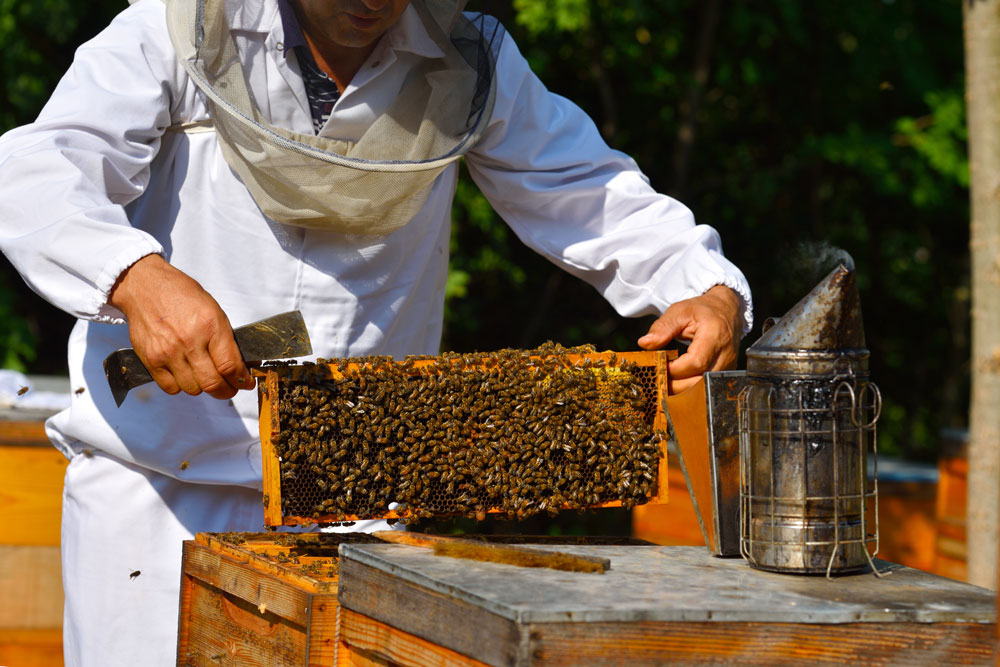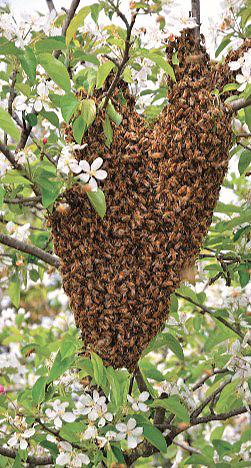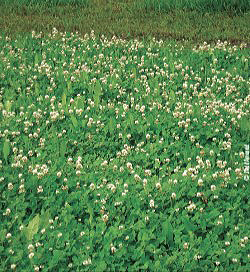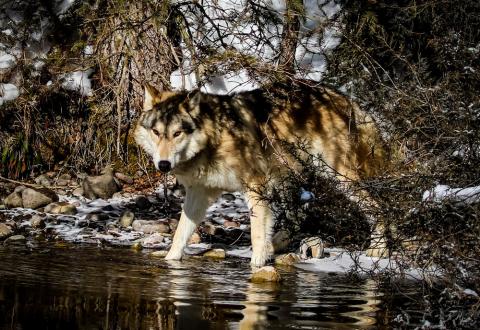Tracy L. Schmidt | Originally published in GameKeepers: Farming for Wildlife Magazine. To subscribe, click here.

Most nature-minded individuals are familiar with the hobby of beekeeping, at least in concept. However, few know the full impacts of beekeeping on land management and wildlife ecosystems. If you keep bees, you’re a true wildlife steward, because the effects go far beyond the backyard.
Humans and wildlife are the direct beneficiaries of the pollination that takes place by the gentle honey bees kept in a beekeeper’s hives. In fact, the increased agricultural production connected to honey-bee pollination is estimated to be more than $14 billion per year. Pollination habitat management is an important part of managing land for both hunting and agriculture. For example, white-tailed deer greatly benefit from pollinated crops like apples, plums, pears and many food plot crops like white clover.
Renewable Resource

better portion of our global food
supply, but they also pollinate your
food plots and mast crop trees.
An area well managed for bees includes a constant rotating of pollination sources. In my home garden, I plant to maximize keeping both native bees and local honey bees happy. I have plants and berries in bloom from spring to late fall. I am rewarded with large yields of berries, fruits and vegetables. For those looking to manage on a large scale, specialized seed mixes are available containing plant species beneficial to pollinators.
In addition to increased crop production, beekeepers reap the byproducts of honey and beeswax. Those byproducts are important commercial resale items. The beeswax is not only used for candle making, but also is used to help preserve the shelf-life of fruits and vegetables. Even some candies are coated in it.
The only thing better than knowing a beekeeper (or living within two miles of one), is being a beekeeper yourself. I’m lucky, because I know one of the best in my home of Wisconsin: Stan "Jake" Jakubek. Jake has been raising honey bees for more than 41 years, and he is the president of the Waupaca County Beekeepers. Although he started out small, he now maintains 120 active hives from which he harvests honey.
Positive Impacts
The relationship between beekeeping and the pollination of plants is important for many reasons. Two positive benefits of beekeeping are honey and increased production of agricultural crops due to pollination by bees. Whether you are a home gardener seeking to improve your yields or a large scale agricultural grower, a healthy bee population is only to your benefit.
Agricultural land use has had both positive and negative impacts on the bee population based upon what has been grown. Crops such as clover and alfalfa that are cut before they blossom are not helpful to bees. If they do not flower, the bees are losing natural resources that held better quality nutrition to non-pollen producing plantings. It is important for those whose crops are cut before blossoming to consider leaving some areas uncut to help the bee population. Alfalfa that goes to blossom is a good source for honey bees. Nectar is necessary for honey production.
The Science of Pollination
Pollen is used as a protein when bees are raising their brood. Pollination occurs when the pollen attached to a bee’s legs and abdomen is spread from flower to flower.
Some plants are hard for honey bees to penetrate with their proboscis to retrieve nectar, such as red clover. As a result, it is important for all growers to put a little thought into helping the pollinators they need to increase their yields. Making it easier on the bees will in turn make your overall growing habitat better. A reduced use of pesticides is also important to creating a supportive habitat for honey bees.
When, Where & Why

about colony collapse disorder, they
also have to deal with unfavorable
weather and the threat of Africanized
honeybees, which are much more
aggressive and can take over a
colony of European honeybees.
Honey bees are attracted to nearly all flowering plants and trees, but they definitely have their favorites. The prevalence of preferred plants has an influence on the resulting types of honey produced by a hive in terms of both flavor and color. For example, White Dutch clover results in a honey with a clover taste; basswood honey has a strong, minty flavor; orange blossom honey has a delicate, smooth flavor; wildflower is a darker honey, goldenrod honey also has a distinct flavor and odor.
In the Upper Midwest, the best months for gathering honey are generally July and August. Weather, however, has an important overall impact in a hive’s production. If it is too cold, dry or wet it impacts the sources of pollen and nectar for the bees. The ideal weather for honey production would be two good weeks of sunny, 78-degree weather. A healthy hive should show signs of lots of flight activity, and a bee that is constantly laying eggs. It will also have mature worker bees present in the hive.
If you want to begin beekeeping
Getting Started:
1. Check for any local ordinances or other restrictions. Some municipalities have special requirements for bee hives.
2. Work with a beekeeping mentor from a local beekeeper association who could help you learn the craft—it’s much faster than making a go of it on your own.
3. Look to see if there are any courses you can take on beekeeping.
4. There are starter kits and plans you can use to build your own hive.
5. Purchase new hives and gear to avoid the possible transfer of disease from used materials.
6. Select a location far away from traffic and recreational land use where your bees will be undisturbed in their hives. You don’t need a flying soccer ball to hit your hive. Your bees are working hard all the time and need their space.
7. Make sure your bees have a water source, either natural, like a pond, creek, river or a man-made one.
8. Bees will travel up to two miles. Because they will fly so far, you don’t have to plant a garden to have beehives as long as the supporting environment exists within that two-mile radius.
The recent “localvore” (a person interested in eating food that is locally produced) surge has certainly increased beekeeping awareness and acceptance. More people are coming to realize the importance of honey bees in a healthy environment. After all, bees support, through pollination, approximately 75 percent of the world’s major food needs. Many plants need pollination for the purpose of fruit and vegetable production. This includes apples, broccoli, pumpkins, squash, strawberries, and tomatoes. Other crops need to be pollinated to produce seeds, such as carrots and turnips. Forage crops used by animals also benefit from pollination, such as clover and alfalfa.
The non-native, European honey bee is frequently used for the pollination of large acreage crop plants because it is able to be transported easily. However, with the onset of “Colony Collapse Disorder,” the renting out of bees commercially has declined. Honey beekeepers are worried about the spread of the disease into their own beehives.

to bloom will benefit your local bees,
but this can also be good for your
local deer herd and the stand of
perennials. You never want to
completely remove a food source—
you always want to leave something
there for your deer. During cooler
parts of the growing season,
perennial legumes will spread from
stolon production, but during the hot,
dry summer months they can
regenerate by flowering and going to
seed.
The spread of the Africanized honey bee has also begun take a toll on the European honey bee, as it is more defensive. The Africanized bee will kill a European honey bee queen and take over her hive. However, it is important to keep populating the European honey bee as it will make it more difficult for the Africanized bee to take over.
There can be 50,000 to 80,000 bees in a single hive. “A good queen will last about three years before she is replaced,” Jakubek said. “The queen is constantly laying eggs during the course of a summer, meaning that several generations of bees will cycle through a hive. The queen is the longest living resident of a hive. Honey bees like to come out of their hives to search for pollen and nectar when temperatures reach 70 degrees Fahrenheit or warmer.”
Long, cold winters resulting in longer time periods for plants to come out of dormancy in spring, late frosts that kill blossoms, and overly hot, dry summers will have a negative impact on the honey bees’ ability to forage for pollen. According to Jakubek, the hives need to be strong and healthy at pollination times for peak results to both agricultural growers and honey harvesters.
“A single hive with a good queen can produce 70 to 100-plus pounds of honey,” he said. “A moisture ratio of 17 percent to 18 percent needs to be present in honey, so it will not spoil. Even if you don’t have a beehive, you can help take care of bees by not spraying pesticides during the times of day when bees are actively working blossoms and planting flowering vegetation.”
Conclusion
If you are looking to start a hive, there are many online resources to help you find honey bees to populate your hives, other beekeeping equipment and education. Honey bees and beekeeping are important to successful agriculture in the United States. Successful pollination will help keep produce prices down by helping to keep supply and demand in a good balance.





























